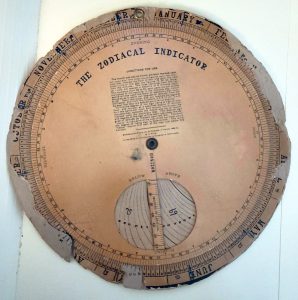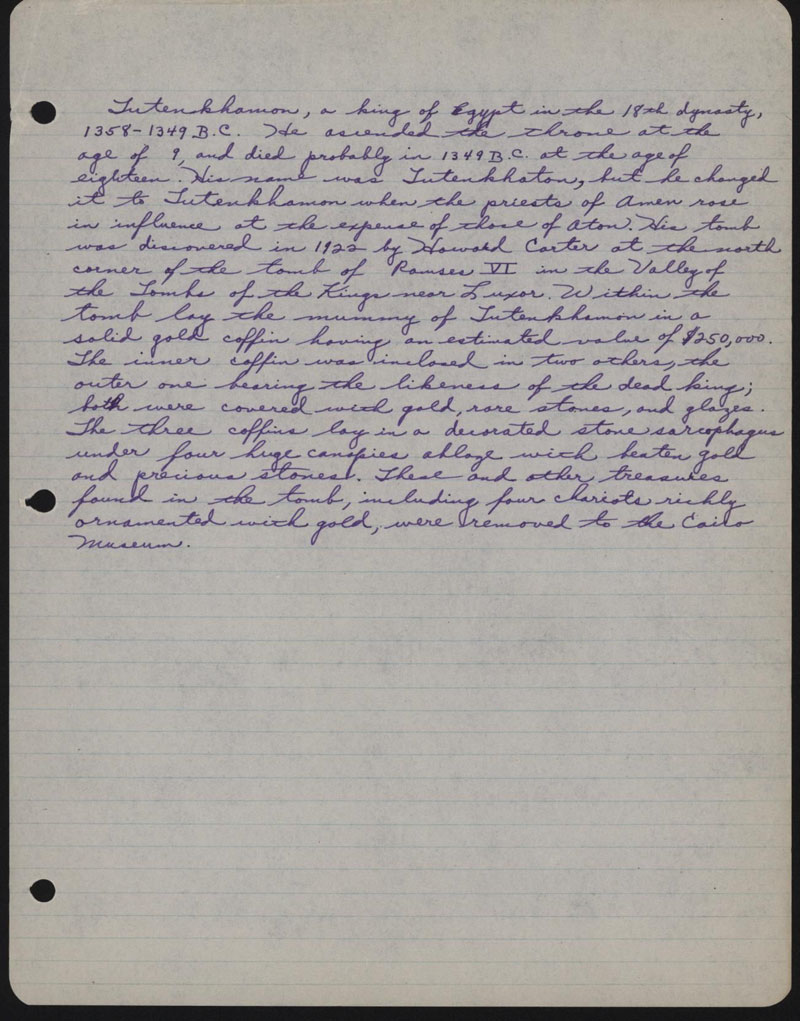By Sammi Merritt
Finding information in the archives can sometimes feel like an expedition through time – a scavenger hunt in countless records to find the holy grail document that you’re looking for, sifting through ancient ruins and dusty boxes for the one scrap of information that will definitively answer your research question. On occasion, this digging will turn up the exact information you were looking for. Other times, you must answer your questions to the best of the ability of the extant sources, and results are not always as conclusive as we would like them to be.
Sometimes, you come across an item that raises far more questions than it answers. For me, this serendipitous moment occurred while browsing the Neil L. Block Papers (RS 35/3/418). This item, found within a folder inconspicuously labelled “Ancient Egypt – Notes On,” is a 12-page document, handwritten in a purple cursive script on lined, 3-hole punched paper.[1] The first page contains a brief abstract about the Pharaoh Tutankhamen: his life, his reign, the discovery of his tomb, and the grave goods found within. The following 11 pages appear to record a question-and-answer session in which the responder describes exactly where and how to find a (presumably still lost) Egyptian tomb. The 67 questions in the document are addressed to “Ouija,” and the entity responding makes references to the use of a board. Mention of a medium implies that, much like the séances conducted as part of Edwin Peebles’ research (RS 35/2/50), this conversation could have been facilitated through the use of a medium as well. The questions in the document sought to clarify the location of a tomb and how to find it, but the answers are cryptic and sometimes contradictory.
Undated, unsigned, with only tangential references to any names, the document is an enigma, lacking enough information answer the key questions that historians want to know about our sources: who created it, when, where, with whom, and most importantly, for what purpose? While it appears to be written in the same hand as some other notes in Block’s papers[2], it is difficult to say with certainty where it came from or what it truly is. Is it a genuine transcript from a séance meant to discover the locations for lost Egyptian tombs? If it is genuine, was Block one of the participants, or is this merely a transcript that he received or collected as part of his work? Did the participants ever go on the journey to locate the tomb? Or is it a draft work of fiction written by Block or one of his colleagues? While the item is certainly intriguing on its own, it lacks critical context from which to understand its origin or its purpose.
This informational impasse illustrates the importance of archival principles in constructing the web of connections that researchers use to place archival material and other primary sources in context. The two key concepts which archivists strive to preserve are “provenance” and “original order.” The provenance describes where material came from – who created it, in what capacity, and as part of what work? The original order of material is intrinsically linked to its provenance, and reflects how the person, department, or organization arranged and used those records through the course of their regular affairs.

What can we deduce about this transcript through its provenance and original order? While the series includes a brief note indicating that the papers were found in someone else’s attic in Minnesota and later transferred to one of Block’s associates in Michigan before making their way to the UIUC Archives,[3] there is little biographical information about Neil Block available anywhere outside of these papers. What we do know is that Block was a computer scientist who also conducted serious study in Astrology, often using the alias “Gary Duncan” for these “less academic” publications. As noted in the finding aid, the original order has also been lost, and the current arrangement reflects the best judgement of the archivist who processed these papers. Thus, the papers are currently arranged into folders sorted alphabetically by subject matter. An alphabetical arrangement is not uncommon for personal files, but in this instance, it does not tell us much about how or when Block referred to this document in the course of his normal work.
Deciphering the context, then, will require some additional digging into Block’s papers. But where to start? For me, a natural starting point is to pick out names, dates, and topics which recur. These can often be cross-referenced with other material to learn more about the context in which an item was created. In the response to question 49, the Ouija says that “Some things will be of interest to Neil,” but without more evidence, it would be difficult to claim that this is certainly referring to Neil Block himself.[4] Question 34 includes a list of participants in the conversation: “Mrs. Brody, Joyce Brody, Linda Brody, and myself.”[5] Do members of the Brody family appear elsewhere in the Block papers? A quick search in the finding aid reveals that, at least at the folder-level, they do not. I did find one letter from a “Joe Brody” in a folder titled “Correspondence” in box 2, which confirms that Block was acquainted with a Brody. [6] However, the letter also lacks a proper date. There is a mention of events in 1950 in the letter, which indicates that it was written sometime after that. A reference to a US Naval Observatory Circular No. 90 gets us closer to the actual date, since that circular was published in 1960.[7] If we had a concrete date for this document, we could perhaps look for other material from around the same date to get a sense for what Block was up to during that time.

Other documents in this series demonstrate that Block had a recurring interest in ancient Egyptian astrology and travelling to Egypt with other astrologers, and we could certainly speculate about whether Block went on a trip to find this tomb. In 1973, he reached out to Educational Expeditions International about participating in an expedition to Egyptian temples,[8] and he also saved a bulletin advertising a tour of Egypt conducted by Atlantis Rising which took place in 1980. [9] When the exhibition of King Tut’s tomb and burial goods made its way to Seattle in 1978, Block saved that information in his files as well.[10] Unfortunately, none of this material proves whether he ever made the trip.
Can we, at the very least, deduce whether the factoids dropped in the transcript were accurate? Is there truly a “Tomb of the Black Latch” concealing an Egyptian princess named Manaton waiting to be discovered in Abu Haraz?
Although I could not find any evidence of such a tomb having been discovered, nor of the prince and princess named in the document, the transcript sheds some light on the aura of mysticism surrounding Ancient Egypt. The hidden clues, secret codes, and cryptic directions given serve to enhance the mystery and intrigue, and although they often contradict each other, it is easy to see the appeal of this kind of treasure hunt. While I doubt that this particular tomb exists, the document recording an attempt to locate it provides interesting insight into the significance of provenance in interpreting primary sources.
Transcription
The document has been scanned and is available in PDF format, but for the purpose of this project I have transcribed it as well. The transcription is available here.
[1] 35/3/418 Neil L. Block Papers, Box 2, Ancient Egypt – Notes On.
[2] 35/3/418 Neil L. Block Papers, Box 4, Letter Box – of Eleanor Block Correspondence, 1928-49.
The purple cursive handwriting notably also seems to appear in a series of natal charts. The correspondence in these folders suggests that Block’s interest in Astrology and related topics was instilled by his mother, an active member of the Rosicrucian Order who requested to have Neil’s natal chart done shortly after he was born.
[3] 35/3/418 Neil L. Block Papers, Box 1, Provenance Information, 2007.
[4] 35/3/418 Neil L. Block Papers, Box 2, Ancient Egypt – Notes On, Question 49.
[5] 35/3/418 Neil L. Block Papers, Box 2, Ancient Egypt – Notes On, Question 34.
[6] 35/3/418 Neil L. Block Papers, Box 2, Correspondence – General, 1948-87. Letter from Joe Brody to Neil Block.
[7] R.L. Duncombe and G. M. Clemence, USNO Circulars 90, December 16, 1960. Provisional Ephemeris of Mars 1950-2000. https://www.cnmoc.usff.navy.mil/Our-Commands/United-States-Naval-Observatory/The-James-M-Gilliss-Library/Publications-of-the-US-Naval-Observatory/Circulars-of-the-US-Naval-Observatory/.
[8] 35/3/418 Neil L. Block Papers, Box 2, Egyptian Temples Expedition, Letter from Marian C. Youngblood at Educational Expeditions International to Neil Block, 1973.
[9] 35/3/418 Neil L. Block Papers, Box 1, Astrology Ephemera, “Egypt – A Thrilling and Educational Experience,” 1980.
[10] 35/3/418 Neil L. Block Papers, Box 1, Astrology Ephemera, American Institute of Astrology Presents “New Directions in Astrology,” Seattle, Washington & the King Tut Exhibit, 1978.

